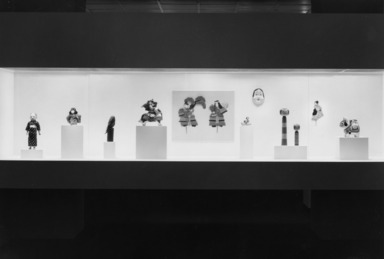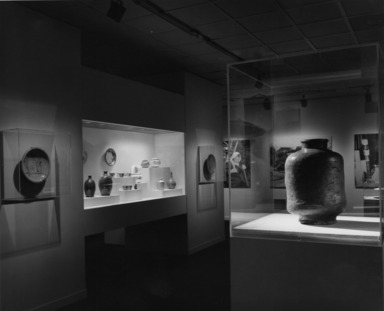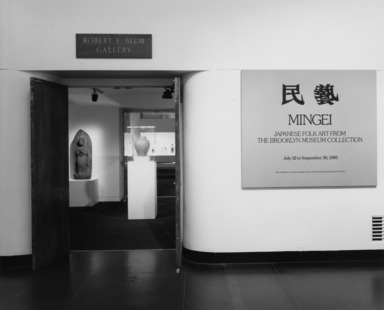

Mingei: Japanese Folk Art, July 12, 1985 through September 30, 1985 (Image: ASI_E1985i001.jpg Brooklyn Museum photograph, 1985)
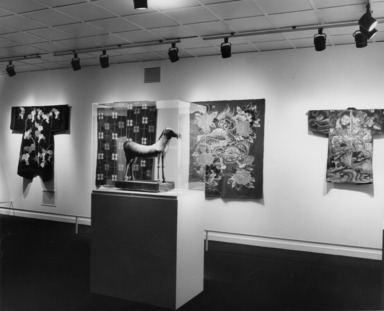
Mingei: Japanese Folk Art, July 12, 1985 through September 30, 1985 (Image: ASI_E1985i002.jpg Brooklyn Museum photograph, 1985)

Mingei: Japanese Folk Art, July 12, 1985 through September 30, 1985 (Image: ASI_E1985i003.jpg Brooklyn Museum photograph, 1985)

Mingei: Japanese Folk Art, July 12, 1985 through September 30, 1985 (Image: ASI_E1985i004.jpg Brooklyn Museum photograph, 1985)
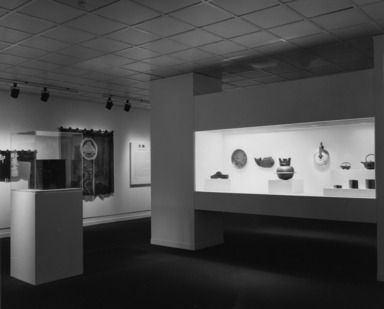
Mingei: Japanese Folk Art, July 12, 1985 through September 30, 1985 (Image: ASI_E1985i005.jpg Brooklyn Museum photograph, 1985)

Mingei: Japanese Folk Art, July 12, 1985 through September 30, 1985 (Image: ASI_E1985i006.jpg Brooklyn Museum photograph, 1985)

Mingei: Japanese Folk Art, July 12, 1985 through September 30, 1985 (Image: ASI_E1985i007.jpg Brooklyn Museum photograph, 1985)

Mingei: Japanese Folk Art, July 12, 1985 through September 30, 1985 (Image: ASI_E1985i008.jpg Brooklyn Museum photograph, 1985)

Mingei: Japanese Folk Art, July 12, 1985 through September 30, 1985 (Image: ASI_E1985i009.jpg Brooklyn Museum photograph, 1985)
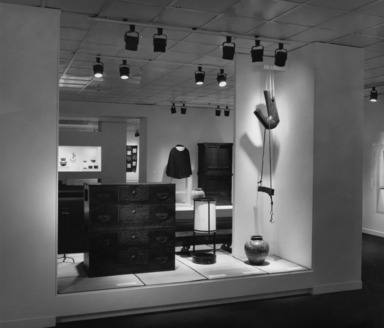
Mingei: Japanese Folk Art, July 12, 1985 through September 30, 1985 (Image: ASI_E1985i010.jpg Brooklyn Museum photograph, 1985)
Mingei: Japanese Folk Art
-
May 7, 1985
In conjunction with the special exhibition Mingei: Japanese Folk Art from The Brooklyn Museum Collection, the Education Division will present a puppet play for children during the months of July and August.
The play, entitled “Mingei Mouse: A Furry Tale,” will use many objects on display in the exhibition as an inspiration for some of the costumes, scenery and characters in the story.
Adapted from a traditional Japanese folktale, the plot revolves around the efforts of a mother and father mouse to find a husband for their extraordinarily beautiful daughter, Nedzumi. Since the prospective candidate must also be the most powerful being in the universe, the mouse family has many unusual and comical encounters with strange and fantastic creatures drawn from the rich vocabulary of Japanese mythology. The story is further complicated by a humble yet handsome mouse fire-fighter (fire mouse) who has fallen deeply in love with Nedzumi, much to her parents’ chagrin. Will Nedzumi elope with the fire mouse? And who is the most powerful being in the universe anyway? Bring your children to “Mingei Mouse” and find out.
Performances will be given every Wednesday, Thursday and Friday at 11:00 a.m. and 1:00 p.m from July 12 through August 16. There will be three special Sunday performances on July 14, 21 and August 4 at 3:00 p.m. The admission fee is $1.50 per child; (children of Family Members will be admitted half price); accompanying adults are admitted free of charge. All group bookings must be made at least three weeks before the performance, and require a minimum $10 deposit. For further information and brochures, please contact the School and Community Programs Department at (718) 638-5000, ext. 221.
Brooklyn Museum Archives. Records of the Department of Public Information. Press releases, 1971 - 1988. 1985, 016.
View Original -
June 3, 1985
Mingei: Japanese Folk Art from The Brooklyn Museum Collection, an exhibition consisting of 115 objects selected from the Museum’s permanent collection, opens at The Brooklyn Museum on July 12 and will be on view through September 30, 1985.
The Brooklyn Museum is unique among American museums in being able to assemble such a comprehensive exhibition of Japanese folk art from its own permanent collection. Included in the exhibition are paintings, sculpture, ceramics, furniture, lacquer, textiles, toys, Okinawan folk art and Ainu artifacts (the Ainu are aborigines living on Hokkaido, the large northern island of the Japanese archipelago). The objects date mostly from the late Edo (1615-1868) and Meiji (1868-1912) Periods, that is, roughly 1800-1910.
The Japanese have never recognized a basic distinction between art (painting, sculpture, architecture) and crafts (ceramics, metalwork, furniture, textiles, etc.) as we do in the West. The distinction is, after all, really quite an arbitrary one. The Renaissance ideal of the artist as a unique individual whose divinely inspired talent sets him apart from mere craftsmen never occurred to the Japanese. The concept was introduced to Japan from the West in the latter part of the 19th century. Prior to that the Japanese took their arts and crafts for granted, regarding them both as skilled trades.
Japan was closed to foreigners from 1639 until Commodore Perry forced its reopening in 1853-54. Before that the Western-style concept of art simply did not exist in Japan. It was introduced about 1871 and two new Japanese words were coined for it: bijutsu (art) and geijutsu (the fine arts).
After Perry reopened Japan, the incredibly rapid industrialization and Westernization of Japan nearly destroyed traditional Japanese crafts. They were saved from oblivion at the last moment largely through the efforts of one man, Yanagi Sōetsu (1889-1961). Yanagi, a philosopher turned literary and art critic, founded the Crafts Movement in Japan. Inspired by William Morris’s Art and Crafts Movement in England, he remarked that there was no word in the Japanese language for folk art. Thus in the early 1920s he invented a new Japanese word for it: mingei (the art of the common people). In 1926 Yanagi and his friends founded the Japan Folk Art Association (Nihon Mingei Kyōkai), which now has its own museums in Tokyo, Kurashiki, Tottori and Osaka.
The Brooklyn Museum’s extensive collection and unique capability in being able to mount an exhibition of Japanese folk art is due in part to the resourcefulness of Stewart Culin (1858-1929), the Museum’s indefatigable Curator of Ethnology from 1902 to 1928. Culin bought Japanese folk art at the source during two collecting trips to Japan in 1909 and 1913-14. At that time, Westernization had not yet destroyed all the old ways, especially out in the countryside. During the past ten years, remaining gaps in the Museum’s Japanese folk art collection have been systematically filled through both purchase and donation.
This exhibition was made possible in part with funds from the National Endowment for the Arts, a federal agency.
Brooklyn Museum Archives. Records of the Department of Public Information. Press releases, 1971 - 1988. 1985, 039.
View Original -
July 12, 1985
A toy-making workshop, drum performance, storytelling session, ceramic demonstration, and a series of gallery talks have been scheduled on the occasion of the exhibition Mingei: Japanese Folk Art from The Brooklyn Museum Collection, open to the public from Friday, July 12 through September 30, 1985.
On Saturday, July 20, from 2-4 p.m., Yasko Karaki will conduct a Japanese toy-making workshop. Audiences of all ages will enjoy making decorative kites, dolls, masks, and other Japanese playthings. Advance registration for the workshop is available by calling (718) 638-5000 ext 232. A limited number of spaces will be open on the day of the workshop on a first-come, first-served basis.
The Taiko drum ensemble Soh Daiko will present its Japanese folk drum performance in the Museum’s Frieda Schiff Warburg Memorial Sculpture Garden on Sunday, July 28 at 3 p.m. The fifteen member group will perform complex and dramatic rhythms in pieces that are both traditional and original.
On Sunday, September 22 at 3 p.m., storyteller Diane Wolkstein will bring to life the myths and legends of Japan with an hour of stories and folk tales. Ms. Wolkstein will be accompanied by a sign language interpreter for deaf and hearing-impaired visitors.
On Saturday, September 28 at 3 p.m., a 1000 year old Japanese ceramic process will be demonstrated by Jeff Shapiro, a potter who lived and studied ceramics in Japan for eight years. A brief slide show accompanying the demonstration will describe the complete pottery process from clay digging to decorative finishing, and will place the pottery into the context of local village traditions.
In addition, Robert Moes, Curator of Oriental Art, The Brooklyn Museum, and curator of the exhibition, will lead three walk-through tours of the exhibit on July 27, August 11, and September 8.
All public programs for Mingei: Japanese Folk Art from The Brooklyn Museum Collection are free with Museum admission. For advance registration and further information regarding these events, please call (718) 638-5000 ext 232.
Brooklyn Museum Archives. Records of the Department of Public Information. Press releases, 1971 - 1988. 1985, 041.
View Original
